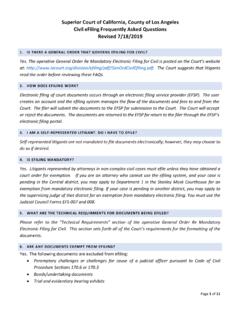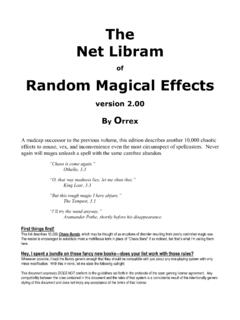Transcription of Super-Acceptance of a “Jacoby Transfer”
1 1 Super-Acceptance of Jacoby Transfers super -acceptances are a useful and popular adjunct to Jacoby Transfers, so much so, that they have become part of standardized bidding for most Bridge Players. The original advantage in using super -acceptances was that after a transfer to either Major suit by Responder, a Super-Acceptance by the 1-NT Opener, shows a hand that has the potential to produce a Game-level contract opposite many responding hands that would otherwise pass a simple acceptance . In addition, the use of super -acceptances act preemptively when Responder holds minimum values and the Opponents are potentially likely to compete following a transfer, and a subsequent pass by the Responder. Over the years, two concepts have evolved regarding when, and under what circumstances, Opener should make a Super-Acceptance .
2 (1) Whenever Responder to an opening strong 1-NT bids 2D, transferring to 2H, or 2H, transferring to 2S, Opener, when holding the maximum possible; , 4-pieces of the suit requested by the Responder s transfer and the top of his/her HCP count (17 HCP s), Opener should make a Super-Acceptance of 3H or 3S, respectively. (2) The LAW OF TOTAL TRICKS, however, suggests that the 3-level would be safe anytime the Partnership has a 9 (+) HCP fit, and therefore Opener should super -accept on all, or virtually all, hands holding 4-card support for Responder s requested Major suit. The question arises, therefore, as to whether Opener should (A) only super -accept when holding maximum values and 4-piece support, as in (1) above, or (B) always super -accept when holding 4-pieces of Responder s requested Major suit, irrespective of the point count of the Opener; , not limited, singularly, to when Opener holds 17 HCP s, as in (2) above.
3 Consensus seems to confirm that using super -acceptances whenever Opener holds 4-pieces, irrespective of point count, as shown above in (2), yields mixed success. At times, the field, not using super -acceptances, has had the auction end at the 2-level, contract making, whereas, taking the Super-Acceptance at all times can backfire; as, often, the Opponents cannot make anything, and a 3-level contract by Opener s side fails. Conclusion: super -accept only when: 1. There is a reasonable chance of a Game opposite a hand that would pass a simple accept, and, 2. When Game is not that likely, and there is a significant danger that the Opponents can compete effectively by entering the auction and balancing. When, and Under What Circumstances, Should Opener Make a Super-Acceptance ?
4 Conditions Favoring Opener s Use of a Super-Acceptance 1. Opener should super -accept with Hearts more often than with Spades and, especially, when holding a doubleton Spade. (The Opponents, under these conditions, are most likely to be inclined to balance seeking a competitive contract in Spades at the 2-level.) 2. Opener should always super -accept with five trumps. (With a 10-card fit, the chances are high that the Opponents can and will balance.) 2 Conditions Against Opener s Use of a Super-Acceptance 1. Opener should not super -accept with questionable working values. (When holding an excessive number of Quacks [Queens and Jacks], Opener should not make a Super-Acceptance .) 2. Opener should never super -accept with a 4-3-3-3 shape. (With a 4-3-3-3 side shape, your offensive potential is reduced by almost a full trick.)
5 Your risk of going down, therefore, is too high, even with a maximum HCP count.) 3. Opener should not super -accept with too many high cards of uncertain worth. (For example: Qx, AKxx, KJx, QJxx. This hand has 16 HCP, but facing a weak Responder, some or all of the outside high cards will not take tricks on offense.) Examples Illustrating These Conditions (You have opened 1-NT and Responder has responded with a 2D transfer) Hand 1: Jx, QJxx, AKxx, Axx (Make a Super-Acceptance here! Even if you were to go down, chances are excellent that the Opponents are making something in Spades.) Hand 2: Qx, AKxx, KJx, QJxx (Do not make a Super-Acceptance here! Your soft values require Responder to have fitting cards to achieve their potential.
6 If Responder is weak, some of your high cards will have no value on offense. However, they may have value on defense. With less offense and more defensive values, make a simple acceptance .) Hand 3: Jx, QJxxx, AKx, Axx (Make a Super-Acceptance here! Always make a Super-Acceptance when holding 5-pieces of Responder s requested Major suit, notwithstanding HCP count.) Hand 4: Jxxx, QJx, AKx, Axx (Do not make a Super-Acceptance here! With a 4-3-3-3 distribution, Opener should never make a Super-Acceptance .) Bottom Line: Reserve your super -acceptances for hands with high cards that are sure to contribute, rather than on those that only have speculative value. Hand 1: xx, QJxx, AKQx, Axx ( super -accept, bidding 3H here) Hand 2: Qx, AKJx, QJx, QJxx (Do not super -accept, here, bid 2H ) On occasion, Responder s left-hand Opponent (LHO) will make an interference call similar to the example shown below.
7 Under these circumstances, Responder, at his/her discretion and under positive circumstances, can elect to make a retransfer, demanding that Opener accept the transfer previously blocked by the Opponent s North East South West 1-NT Pass 2D 2S Pass Pass 3D Pass 3H Pass Pass or 4H Pass ---------------------------------------- ---------------------------------------- Larry Cohen s 3-Way Super-Acceptance Responses when holding 4-pieces of Responder s Major (1)With 4-pieces of Responder s implied Major and 15 16 (-1) HCP s: 1-NT 2D / 2H 3H/3S (2)With 4-pieces of Responder s implied Major, a 4-3-3-3 distribution, and 16 (+) - 17 HCP s: 1-NT 2D / 2H 2-NT (3)With 4-pieces of Responder s implied Major, a doubleton, and 16 (+) -17 HCP s: 1-NT- 2D / 2H 3 of the suit containing the doubleton





